With Plant-based Protein, Ethan Brown M.P.M. ’97 Sets Out to Change America’s Eating Habits—and Maybe Save the World
By Chris Carroll | Illustrations by Jon StichThat first bite into an expertly made hamburger is a sensory explosion, and a journey of sorts: It starts with the soft, subtly sweet bun, which gives way to a tangy mix of sauces followed by cool layers of fresh tomato and lettuce and crispy pickles, before you reach creamy molten cheese; and finally, the destination: the smoky char, the fatty richness, the just-plain meatiness of the beef patty that lights up pleasure centers in your brain.
Self-professed meat lover Ethan Brown M.P.M. ’97 is right there with you on this gustatory odyssey, but there’s a twist. As a vegan and the founder and CEO of Beyond Meat, which has mushroomed from a small University of Maryland-backed startup to the nation’s leading plant-based meat company, Brown is pushing for a detour: a burger that bypasses the cow.
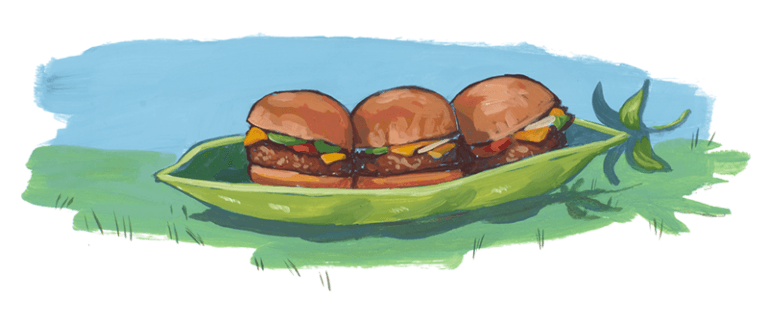
As he tells it, animal-free meat isn’t a contradiction, and neither is being a carnivorous vegan. While millennia of history and culture have accustomed us to the fact that meat is something carved from an animal carcass, modern science (and Brown spends millions a year on research and development) is asking a new question about what the word means. What if, instead of defining meat by its origin, we simply decide that if it looks, tastes, smells and cooks like meat, then that’s what it is?
“What we’re doing, I don’t think about it as meat substitutes or meat alternatives,” Brown says in an interview with Terp. “We’re actually building a piece of meat directly from plants.”
As consumers grow increasingly concerned about livestock’s role in global warming and the health effects of eating too much animal protein, the 48-year-old Brown stands center stage in a national conversation about meat’s place in society.
Various surveys show that 30% to 50% of Americans want to reduce their meat intake, and people are snapping up Beyond Burgers and Beyond Sausage products at a skyrocketing number of retail locations and restaurants. The company reported its first quarterly profit in the fall, with revenues up 250% from a year earlier, after a wildly successful spring IPO. The 11-year-old company’s competitors are expanding their reach as well, from Impossible Foods, another scrappy startup with a Maryland connection (see below), to major meat producers like Tyson Foods and Smithfield Foods.
With an outlook and approach to business deeply influenced by his father, an environmental philosopher and a founder of the School of Public Policy, Brown sees the El Segundo, Calif.-based Beyond Meat as a mission—one aimed at improving human health, reducing the impact of animal agriculture on the environment and improving farm animal welfare—as much as a growing company. A legume-based Beyond Burger, according to a study the company commissioned in 2018 from the University of Michigan, generates 90% less greenhouse gas and has a tiny fraction of the effect on water and land use a beef burger does.
The growth of plant-based meat has generated some pushback as well, ranging from farming groups that have successfully lobbied for state laws limiting what can be marketed as meat to questions about the science behind claimed environmental or health benefits—and then there’s the “hands-off-my-cheeseburger” political commentary.
But Brown’s not about to confiscate your cheeseburger, condemn your weakness for prime rib or carry away your chili dog. A prime motivation was to give his own meat-eating children an appetizing alternative to eating animals. (Now 14 and 15, both went vegetarian several years ago.) And that’s basically his idea with Beyond Meat: Stop the eating of animals by selling diners on not just the environment and animal justice arguments, but the taste as well.
“We love meat as humans, and I think we want to keep eating it,” Brown says. “So let’s figure out a way to do it that’s good for us and good for the planet.”
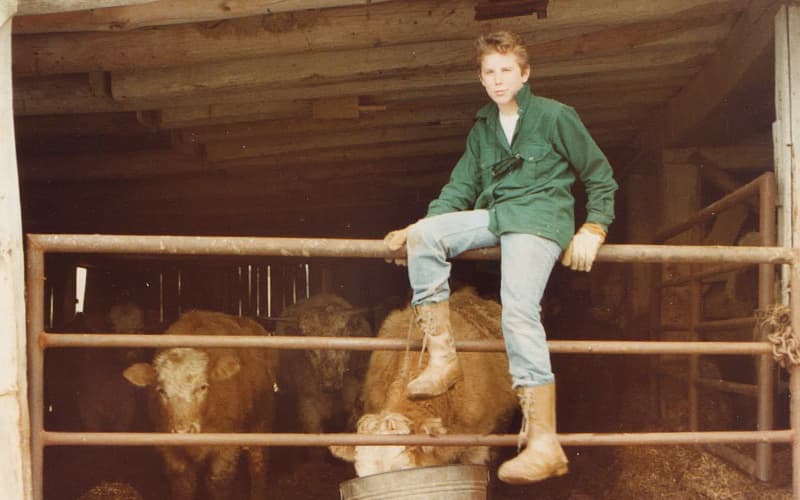
Peter Brown, Ethan’s father, has never been a fan of city living. The former UMD professor focuses his academic work on humanity’s relationship with nature, and found its real-world counterpart in his second vocation: farming.
From Ethan Brown’s earliest days, living first in D.C. and then in the University Park neighborhood next to College Park, he accompanied his father on agricultural sojourns around Maryland, including to a 500-acre farm the Browns still own in the rugged landscape west of Cumberland, Md., where they set up a dairy operation.
“I fell in love with the whole scene,” he says. “In my office today, I have pictures of the farm.”
Brown spent much of his childhood at the farm exploring the pristine woods of the remote property and learning about animals, sometimes by trapping, observing and releasing them.
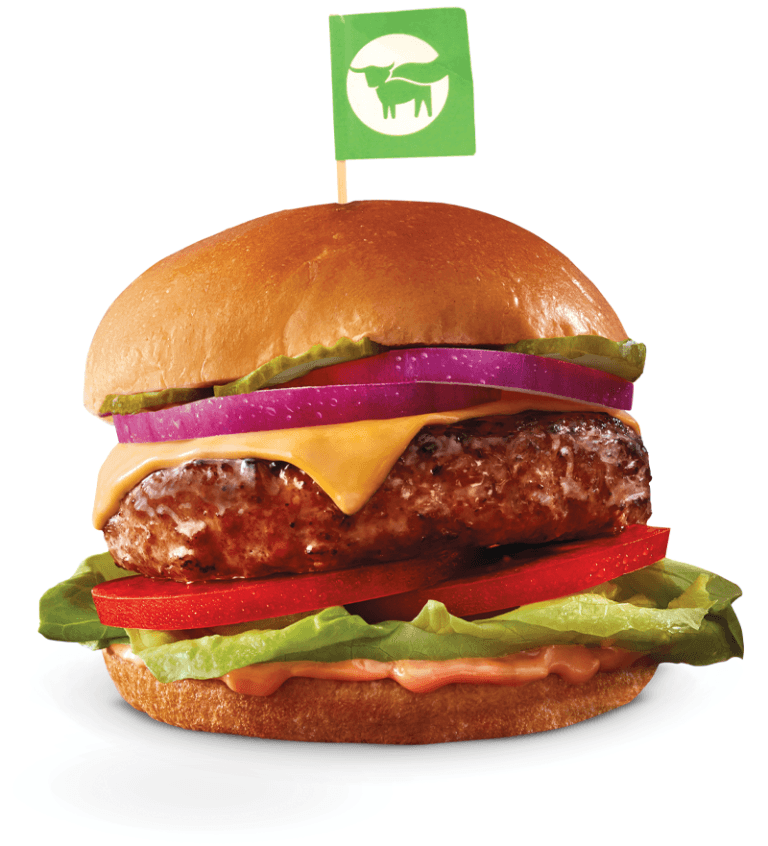
He was also having his first stirrings of conscience about how they’re used. Peter Brown, now a professor and head of the Leadership for the Ecozoic partnership at McGill University in Montreal, estimates Ethan was 7 when he landed on the problem of how society treats pigs, bacon providers to most of us, but interesting and intelligent creatures in their own right to the young Ethan.
“We had a pet dog, and we would often talk about why the dog was kept and cared for until his old age, and why a pig, which is similar in many ways to a dog, is slaughtered at an economically ideal time,” he says. “He could never come to grips with why the pig’s life was considered of no importance.”
The elder Brown didn’t provide any easy answers, encouraging Ethan to delve into the question himself, inspired by sources ranging from Thoreau (Ethan’s middle name is Walden) to the family’s Quaker perspectives.
“He never told me, ‘Here’s how you should think,’” Ethan recalls. “He did teach me to ask questions and to try to interpret the world.”
Over the years, his idyllic childhood image of farming began to contrast with what he was increasingly learning about the reality of high-volume meat production in America, leading him toward a conclusion: “If I viewed myself as somebody who was fair, then what lens was I using that allowed me to cuddle one of these animals and cut the other one?”
Brown is motivated by a deep respect for all forms of life, says Seth Goldman, the founder and former CEO of Honest Tea, who became a Beyond Meat investor in 2012 and now is the company’s executive chair.
“He knows you’re not going to build a brand on a guilt trip,” he said before a recent on-campus talk in the Robert G. Hisaoka Speaker Series. “So he focuses on all the positive aspects of the brand: health and vitality, the fact the product has more protein than beef and no cholesterol, protection of the environment. And as a side benefit, we’re taking billions of animals out of the process.”
Brown first turned to vegetarianism as a teenager, then dropped it while attending Connecticut College, where he graduated in 1994 with a double major in history and government. Ready for adventure, he traveled internationally, including taking a job with a contractor to the State Department in war-torn former Yugoslavia.
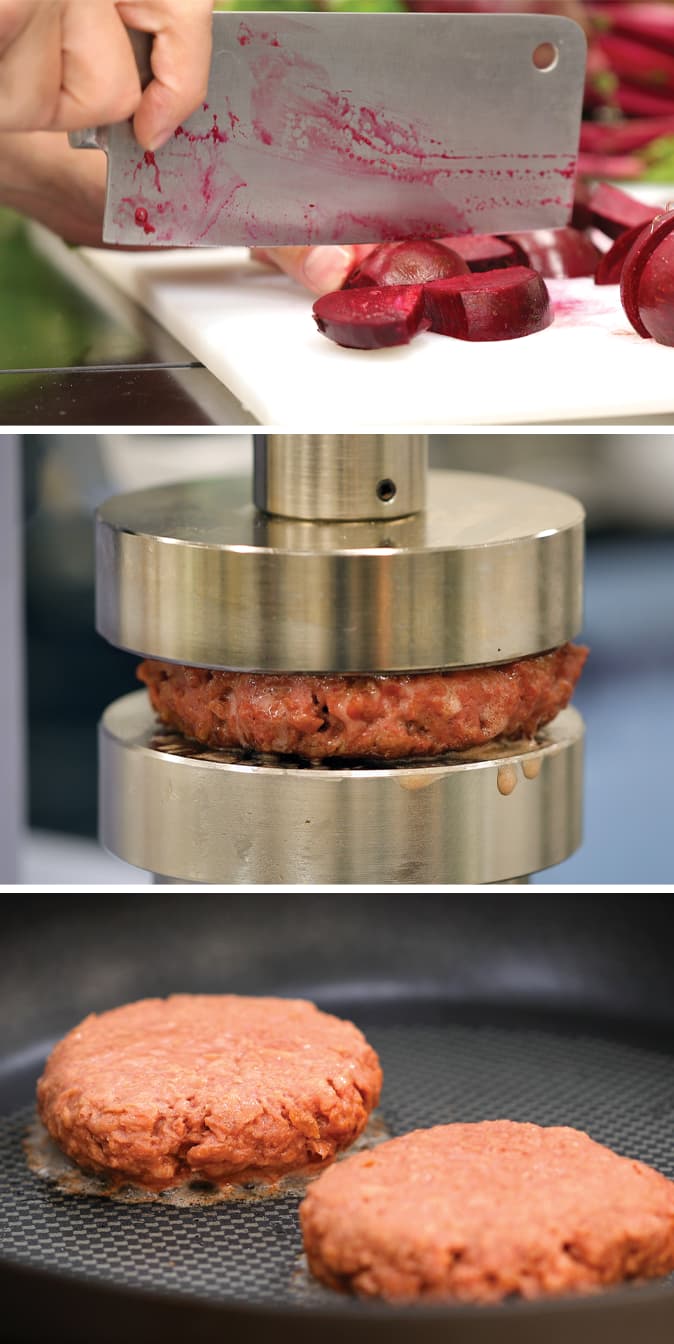
Still searching for direction, he enrolled in the UMD School of Public Policy’s Master of Public Management (M.P.M.) program in 1995. He remembers sitting in his father’s office in Van Munching Hall one day, grousing about wanting to have more time for fun and lacking a clear career plan, only to have the philosopher deftly redirect him. “My dad said to me, ‘What do you view as the greatest problem in the world?’ And I thought about it a lot, and came back later and said climate. If we don’t solve for climate, all the other stuff doesn’t matter, there’s going to be so much chaos. And he said, ‘Well, then you should probably think about your career through that perspective. How can you help solve that problem?’”
Brown entered the clean energy field after graduation, including work on electricity restructuring to support renewables and later hydrogen fuel cells. After more than a decade in the alternative energy sector, however, Brown began to wonder whether he was focusing on the most important source of greenhouse gas emissions. Now fully vegan, he realized that the massive contribution of greenhouse gas from another fuel-related sector (if you think of food as fuel, anyway) was hardly being addressed: animal agriculture, which some sources claim is the world’s largest contributor of greenhouse gas, and which all agree is at least one of the drivers of climate change.
“It dawned on me, we’re attending all these conferences and spending enormous amounts of money chasing slight gains in efficiency in fuel cells, and then they’d go have a big steak dinner—total disconnect,” Brown says. “And I realized you don’t want to spend your whole life working, trying to solve a problem, only to find out you and your colleagues are ignoring a major contributing factor.”
While still in the energy industry, Brown began studying the fundamentals of the substance he had decided to replicate, realizing that from one perspective, meat was pretty simple.
“It’s just five things: amino acids, lipids, trace minerals, vitamins and water,” he says. “The ‘aha’ moment was when I realized none of those things are exclusive to the animal.”
Could he find a shortcut that would take animals out of the process, transforming the five building blocks directly from plants into a viable meat facsimile? “The answer through science is that you can, but I needed people to help me.”
At the University of Missouri, Brown found scientists who had created technology to reset the bonds in plant proteins and simulate the fibrous structure of muscle tissue, licensing the technology. Now that he had a foundation, he needed to make it appetizing, so he turned to the Maryland Industrial Partnerships (MIPS) program, which is funded by the state to connect researchers at UMD and other state institutions with Maryland companies. MIPS Associate Director Ronnie Gist connected with Brown as fellow Terps basketball fanatics. (Brown makes yearly trips to catch games at the Xfinity Center with his high school freshman son, who has his sights set on playing for the Terps.) Gist remembers the young CEO, who’s built like an NBA shooting guard at 6 feet 5 inches tall and given to wearing T-shirts and jeans, as both easygoing and highly focused.
Gist and colleagues helped Brown connect with Martin Lo, then a UMD professor of food science and nutrition who now owns a company that works around the world to reduce pesticide use. Together, they worked to turn the product from the Missouri technology into something less rubbery and more palatable. A new recipe allowed them to ditch soy, which poses an allergy issue for some, and instead base the product primarily on protein from a less controversial legume—peas—as well as other non-genetically modified plants, practices the company still insists on. But palatability remained the guiding light, Lo says.
“The texture we started with was terrible,” he says. “So we found a natural product to help tenderize the meat, and it became more like real chicken—just like pulled chicken from a place like Boston Market.”
As part of the funding process, Gist visited the family farm, not far from where Brown was renting space in Cumberland and making plant-based chicken chunks. He was fascinated by a herd of pigs Brown had collected, not to turn into bacon, but to satisfy his childhood urge to give at least a few porkers more parity with pampered pooches.
The “Chicken Free Strips” were good enough, and Lo’s connections in the food industry strong enough, that Beyond Meat was able to begin selling them at Whole Foods Market locations in 2012. Along with an investment from the venture capital firm Kleiner Perkins, it was a step Brown says put the company on the map. Beyond Meat developed its first beef-like product in 2014 as other high-profile investors came on board, including Twitter co-founder Evan Williams, actor Leonardo DiCaprio and Microsoft co-founder Bill Gates, who in a 2015 essay pondered the true costs of meat: “The richer the world gets, the more meat it eats; the more meat it eats, the bigger the threat to the planet. How do we square this circle?”
To fulfill the promise of the company name, Beyond Meat’s modern food science facility just outside Los Angeles is where the magic needs to happen.
The recipes start with a mix of pea, rice and mung bean proteins that undergo a proprietary process of heating, pressurizing and cooling. The resulting material then pours from the extruder, a technology also in use on a much larger scale at Beyond Meat’s production facilities in central Missouri. Brown has compared the machines to “a large steer” in both size and function, consuming plant material and creating meat-like protein, which undergoes subsequent steps to add flavors and textures.
In a stark white sensory testing room down the hall from the extruder, executive chef Cris Sanchez slides a tray across a table laden with dishes including a bratwurst, a hamburger and an empanada. They feature products already on the market, like packaged Beyond Beef, and others that aren’t yet. The Beyond Sausage Sandwich would debut at Dunkin’ locations nationwide the following day. (The company also recently inked distribution agreements with McDonald’s and Denny’s.)
The finely tuned production process that makes these deals with mainstream American restaurant chains possible also provokes critics of plant-based meat. In August, vegan and Whole Foods CEO John Mackey, who helped Beyond Meat gain footing, didn’t name names, but said “some of these (companies) that are extremely popular now that are taking the world by storm, if you look at the ingredients, they are super, highly processed foods.”
Harvard University nutrition and environmental health faculty voiced similar concerns in an October opinion piece in the Journal of the American Medical Association, and cited a lack of independent, peer-reviewed research studies to substantiate health or environmental benefits.
Professor Chad Stahl, chair of UMD’s Department of Animal and Avian Sciences, called the new products an achievement for food science, but questioned marketing that he said plays on public fears about the fate of the planet or people’s heart health, when science hasn’t caught up with the claims. Is plant-based meat the new margarine, he asked, once widely touted as healthier than regular butter?
“My problem is not that people are making these products,” he says. “I don’t like how they are marketing them.”
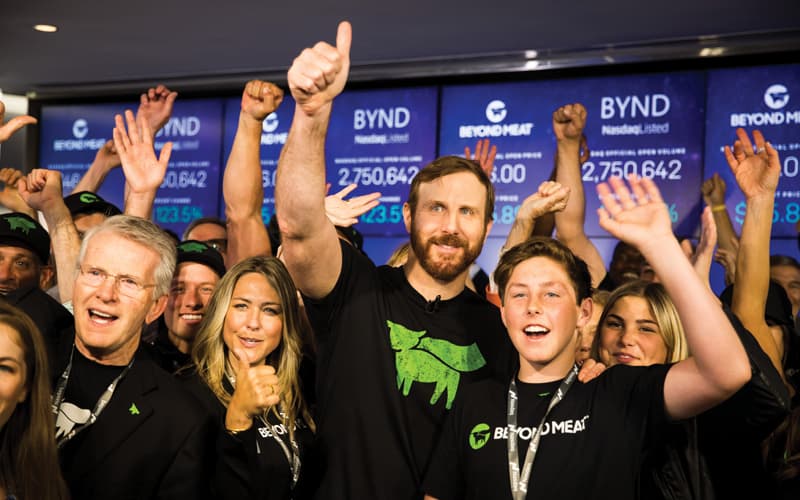
Brown allows he was “disappointed” by Mackey’s criticism, and points out that Beyond Meat isn’t supplanting kale and walnut salads in vegans’ diets—it’s replacing ubiquitous American junk food with a plant product boasting some superior dietary measures and a production process free of antibiotics or potentially harmful chemicals used in meat production. Arguing against processing, he says, is similar to arguing against cooking.
“Process just means a series of steps,” he says. “So if someone thinks that food is not healthy that’s processed, they’re going to have to give up pasta, or give up anything that’s gone through any steps other than pulling it off the tree or taking it from the ground.”
If people lined up for broccoli like they do at the In-N-Out Burger a few blocks north of Beyond Meat HQ, Brown would never have seen a need to step in. “But you’ve got to take into account how most Americans actually eat,” he says.
Unlike some entrepreneurs, Brown doesn’t insist his products are perfect, which to him means perfect facsimiles of animal meats. He wouldn’t, for instance, claim a Beyond Burger trounces the classic Double-Double from In-N-Out in a head-to-head burger battle—yet.
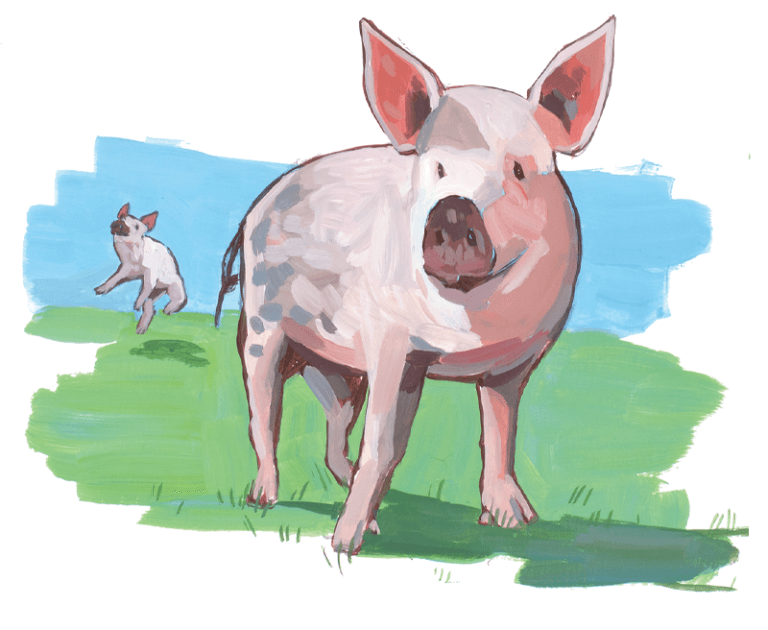
Achieving that is the mission of the approximately 70 scientists on his staff of about 400 employees; most are divided among four groups, each of which focuses on getting ever closer in the areas Brown says the product must continually improve: flavor, aroma, appearance and texture. FAAT for short.
“We believe that if you can close the gap on all four of those, you can create a product that’s indistinguishable from animal protein,” Brown says.
In a lab, lead analytical scientist Parker Lee demonstrates one way the company measures texture using a device similar to a small industrial press. It slowly squishes a freshly cooked patty, measuring its resistance. Elsewhere, on a screen next to an electron microscope, he displays a juxtaposition of the tiny structure of Beyond Sausage with that of pork sausage. They look similar, but the mixture of fat and protein in the plant-based product appears slightly simpler, with larger, less evenly spaced globs of fat. But that’s just the current version.
“Year after year we just iterate, and it’s a thousand failures to one success,” Brown says. “But all you need is one success.”
He doesn’t plan to stop with one, or two. The crowning jewels of plant-based meat are bacon and steak. Those are much harder to recreate than sausage or ground beef, because they’re “naked,” Brown says—whole pieces of meat with the natural structures of the animals on clear display.
Brown’s rescue pigs, which he moved from his Maryland farm to a sanctuary in Tennessee after relocating Beyond Meat to California, are rooting for him to succeed. TERP
At Impossible Foods, Alumna Uncovers Meat’s Mysteries
That other big plant-based meat company has a healthy Maryland connection as well.

Ranjani Varadan Ph.D. ’04 (left) is vice president of research and development at Impossible Foods—basically, the scientist leading the company’s drive to master what makes meat meaty, and reproduce that heady essence in Impossible Burger patties. The product made a cultural splash last year with the rollout of Burger King’s beef-free Impossible Whopper.
It might sound like an odd assignment for a lifelong vegetarian who has never felt the call of a juicy burger. “I really don’t,” she laughs. “(Impossible Foods founder) Pat Brown has said the Impossible Burger is not targeted to vegetarians, but to the real hard-core meat eaters.”
But when it comes to recreating meat from plants, loving the taste of cooked cow pales in significance to an agile scientific mind.
At UMD, Varadan delved into protein science under biochemistry Professor David Fushman, arriving with little background in the experimental techniques he uses. She quickly acclimated and earned her degree in four years—record speed for his lab—doing pioneering research in protein signaling.
“Ranjani was my first graduate student, and I probably still rank her as my top one,” Fushman says. “She can produce a lot of data and analyze it very quickly, but it’s not just hard work … she’s inventive and thoughtful.”
After several academic postings, Varadan joined Impossible Foods at its founding in 2011, rising to director of protein discovery, then vice president of R&D last year. Although researchers with her training frequently find a place in the pharmaceutical industry, she leaped at the chance to make a positive impact on the global environment.
“I think it’s very rare that your professional interests intersect with something mission-based, that you believe in,” she says.—CC
Issue
Winter 2020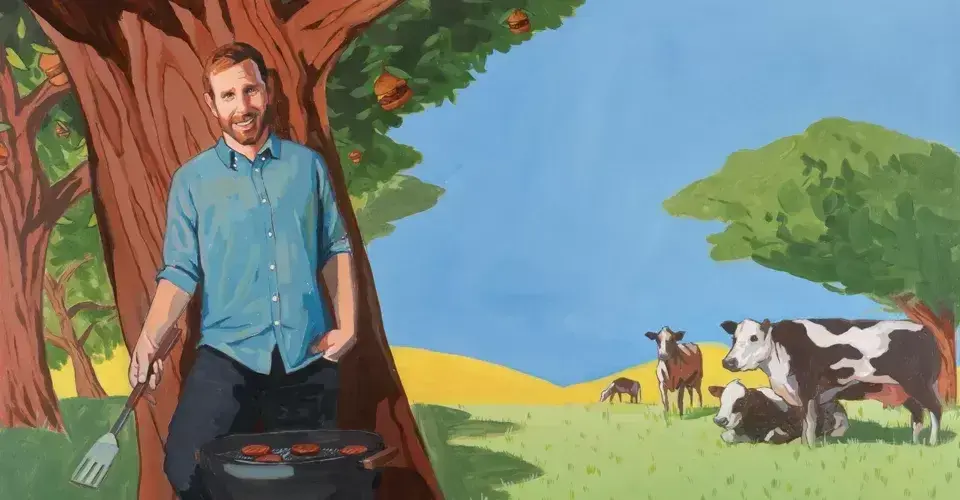
Mars
3 years ago